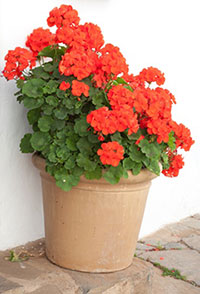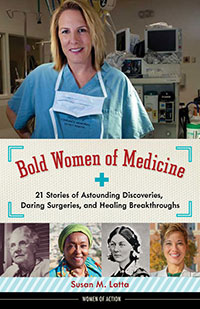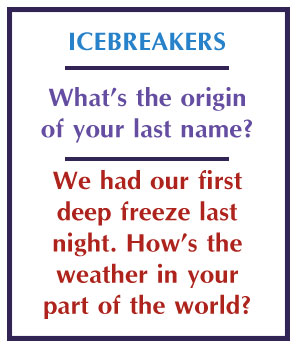Five Steps to a Successful Nonfiction Interview
 I love flowers but no one would ever call my thumb green. Each spring however, I drag the pots to the front step, fill them with soil, plant red geraniums surrounded by marigolds, and water when nature forgets. And when the school buses rumble down the street, I am delighted to empty the pots for another season.
I love flowers but no one would ever call my thumb green. Each spring however, I drag the pots to the front step, fill them with soil, plant red geraniums surrounded by marigolds, and water when nature forgets. And when the school buses rumble down the street, I am delighted to empty the pots for another season.
Gardening in nonfiction is preferable. I have learned that there, too, you must dig and cultivate, and a nonfiction interview is a great place to start that digging.
 One of the subjects in my book, Bold Women of Medicine is Adele Levine, a physical therapist specializing in prosthesis work for soldiers. I pulled a few anecdotes from her book, Run, Don’t Walk: The Curious and Chaotic Life of a Physical Therapist Inside Walter Reed Army Medical Center but realized I needed fresh information.
One of the subjects in my book, Bold Women of Medicine is Adele Levine, a physical therapist specializing in prosthesis work for soldiers. I pulled a few anecdotes from her book, Run, Don’t Walk: The Curious and Chaotic Life of a Physical Therapist Inside Walter Reed Army Medical Center but realized I needed fresh information.
During an interview, I asked her to tell me of a time outside of medicine when she needed courage. She responded that as she wrote her book she didn’t think anyone took her writing seriously. She was sure “that in about ten minutes I was going to be tossed across the lobby by an angry group of editors for wasting their time.” Instead she walked into the Random House conference room and experienced what “felt like a ticker-tape parade. They were shaking my hand and patting me on the back. It was not at all what I thought was going to happen.”
This is the kind of quote I never would have received if I didn’t ask a specific question. Details like a “ticker-tape parade” are important because they aid the reader in imagining what another person has experienced.

Here are five steps to help you dig for the good stuff.
- Define the purpose of the interview (or decide what to plant). Is it informational? Biographical? Defining the purpose will keep you on track and make the most of your subject’s time. What drew you to the person? Is it her career, hobby, or another reason? What are you or your readers curious about? After you know what you want to get out of the interview, prepare thoroughly by reading everything you can about the interviewee. The more you know about the subject the easier it will be to focus your questions.
- Make a list of questions (sow the seeds of the story). Always have more questions than you think you will need. Type one or two questions on each page, leaving plenty of space for the answers. Avoid questions that can be answered with yes or no. Instead of “do you like practicing medicine?” ask “what is your favorite part of practicing medicine?”
 Begin with an icebreaker such as asking about the origin of her last name, or even the weather. Tread lightly when asking difficult questions. Ask broad questions first, then ease into the topic. Swapping stories and keeping the interview conversational will help uncover concrete anecdotes. The stories with the tiniest of details, the natural dialogue, and vivid descriptions are what will help your nonfiction story shine.
Begin with an icebreaker such as asking about the origin of her last name, or even the weather. Tread lightly when asking difficult questions. Ask broad questions first, then ease into the topic. Swapping stories and keeping the interview conversational will help uncover concrete anecdotes. The stories with the tiniest of details, the natural dialogue, and vivid descriptions are what will help your nonfiction story shine.
Use a tape recorder (only with permission), if you feel you won’t be able to write fast enough.
Interviews are unpredictable. Plan that the conversation will veer off in ways you didn’t expect. Being prepared will allow you to use that interruption to your advantage and come up with a unique perspective on your subject.
- Ask for clarification of an answer (weed out the mysteries). One way to do this is to paraphrase the subject’s answer before moving on to the next question. This way if you have misunderstood, the subject can correct you.
- Listen in an open-minded way (appreciate all of the plants). Try to understand the answer in your subject’s point of view, not your own. Don’t be so focused on writing down their answers that you forget to listen well. Use phrases in your notes that will help you remember what the interviewee said. The added bonus of an in-person interview is that you can note nonverbal cues such as smiling, grimacing, and pondering to truly understand your subject.
- Type up your notes immediately (unearth those hidden facts). This will decrease any errors and cement the conversation in your memory. Thank the interviewee for their time and tell them you will send a copy of the finished manuscript for their approval. Don’t forget to send a thank you note.
Now you know what will come up in your garden because you defined the interview’s purpose, sowed seeds by asking intriguing questions, and unearthed surprising facts from your notes. Lastly, pull your thoughts together into a big bouquet of quality nonfiction. And you didn’t even have to get dirt under your fingernails!

Susan, your tips for conducting a successful nonfiction interview are spot-on! I look forward to reading your forthcoming book; it sounds fascinating. I am also a kidlit nonfiction author, and I was alerted to your interview by another children’s nonfiction author, Heather Montgomery. I’m Sara Latta (my sister’s name is Susan!), and I’m so happy to make a virtual acquaintance with another Latta in the children’s/nonfiction writer community. I don’t know if we’re related but it might be fun to be in touch. Best regards,
Sara Latta
Hi Sara,
Thanks for reading! I have seen your name on other kid lit sites and wondered the same thing. My husband is Robert Latta, and he was born and raised in St. Louis. So funny too that you have a sister named Susan. Let’s connect, I’d love to hear about your writing. Susan